by David B. Kelley
The Mesoamerican bar-and-dot number system has similarities to the Chinese solid-and-broken-bar system.

Bar-and-dot System: The numbers 1 to 9 represented using the Mesoamerican bar-and-dot system; a dot represents "1" and a bar represents "5".
Terminology
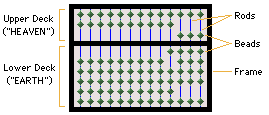
The 2/5 Chinese Abacus: The components of a 2/5 (indicating 2 beads in the Upper Deck and 5 beads in the Lower Deck) Chinese abacus are identified in this image. The beads are arranged to show the decimal number 1,999.
The Comparisons
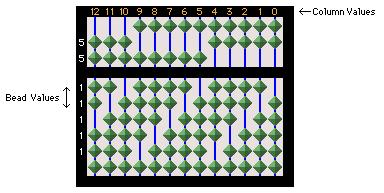
Example Decimal Abacus: The abaci showing simple column values and bead values appearing in the examples below, display column-values along the top and and the bead-values on the left.
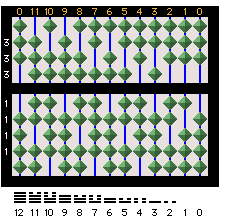
3/4 Abacus: simple column values with Chinese solid-and-broken-bar signs and number values below. This is NOT a functional Duodecimal (base 12) Abacus, and although each lower deck bead has a value of "1", each Broken Bar sign below, actually has a numeric value of "2". |
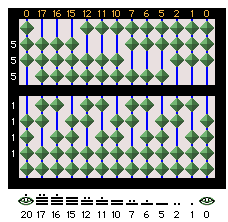
3/4 Vigesimal Abacus: simple column values with Mesoamerican bar-and-dot signs and number values below. This is a fully functional Vigesimal Abacus, but owing to a 13-column limitation, only 11 bar-and-dot signs and values, and two uses of the "zero" sign are shown. |
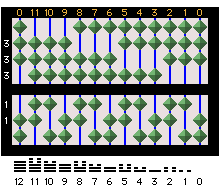
3/2 Duodecimal (base 12) Abacus: simple column values with Chinese solid-and-broken-bar signs and number values below. This is a fully functional Duodecimal Abacus, and to make it functional, the value of the Broken Bar sign has been changed to "1", and the signs and values re-arranged. |
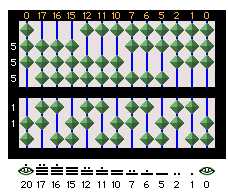
3/2 Abacus: simple column values with Mesoamerican bar-and-dot signs and number values below. This is NOT a vigesimal abacus. |
Examples of Place-Value Use
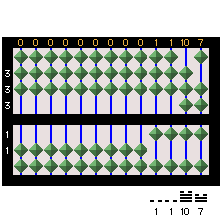
3/2 Duodecimal Abacus: place-value column values with Chinese solid-and-broken-bar signs and number values below showing the decimal number 1,999.
|
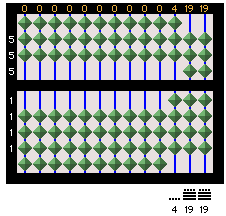
3/4 Vigesimal Abacus: Regular place-value column values with Mesoamerican bar-and-dot signs and number values below showing the decimal number 1,999.
|
|||||||||||||||||||||||||||

3/2 Duodecimal Abacus: place-value column values with Chinese solid-and-broken-bar signs and number values below.
The solid-and-broken-bar signs are markedly similar to the Mesoamerican bar-and-dot signs, especially those associated with the Calendric use of the Mesoamerican signs. In the case of the example above, we see a total of five solid-bar signs and four broken-bar signs each consisting of two sub-parts, are very similar to the five Mesoamerican bar-signs and eight dot-signs. |
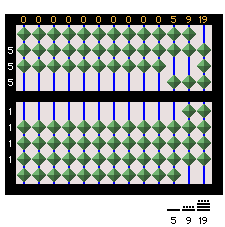
3/2 Vigesimal Abacus: Calendric place-value column values with Mesoamerican bar-and-dot signs and number values below.
The abacus shown above has been modified to reflect the Calendric use of the Mesoamerican vigesimal number system. This means that the third column has a limit of three upper-deck beads (with each bead = "5") and two lower-deck beads ((with each bead = "1"). Accordingly, all columns to the left of the second column have different values from those derived from the Regular vigesimal abacus presented earlier. |
|||||||||||||||||||||||||||
Final Comments
The solid-and-broken-bar (I-Ching) number signs represent one of the several variant Chinese number-symbol systems. The Chinese I-Ching number symbols are based on a combination of the two Yao (
2 The Sacred Books of China. The Texts of Confucianism, Part II: The Yi King (Chapter 1, Paragraph 2). James Legge, trans. 1882.
For more information about Mayan Calendars see: Calendopaedia, The Classic Maya Calendar and Day Numbering System and the corresponding Wikipedia entry.
